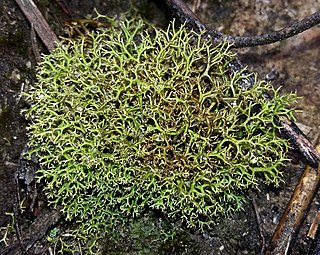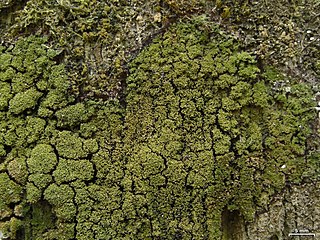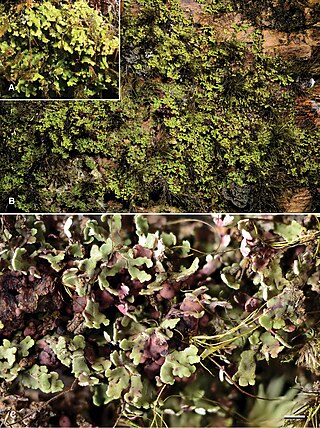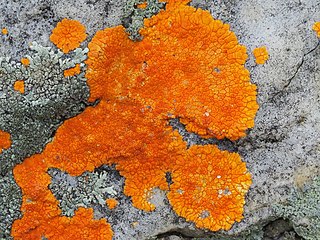Scutula is a genus of lichenicolous fungi in the family Ramalinaceae.

Cladia is a genus of lichenized fungi in the family Cladoniaceae. Cladia species have a crustose primary thallus and a fruticose, secondary thallus, often referred to as pseudopodetium. The type species of the genus, Cladia aggregata, is widely distributed, occurring from South America, South Africa, Australasia and South-East Asia to southern Japan and India. Most of the other species are found in the Southern Hemisphere.
Physcidia is a genus of lichen-forming fungi in the family Ramalinaceae. The genus was circumscribed in 1862 by American lichenologist Edward Tuckerman.

Phyllopsora is a genus of lichenized fungi in the family Ramalinaceae. It was circumscribed by Swiss botanist Johannes Müller Argoviensis in 1894.

Krogia is a genus of corticolous lichens in the family Ramalinaceae. It occurs in tropical humid forests and rainforests. The genus was circumscribed by Norwegian lichenologist Einar Timdal in 2002, with Krogia coralloides assigned as the type species.
Toniniopsis is a genus of crustose and squamulose lichens in the family Ramalinaceae. The genus was circumscribed by Swiss lichenologist Eduard Frey in 1926, with Toniniopsis obscura designated the type and only species. The genus name of Toniniopsis is in honour of Carlo Tonini (1803–1877), who was an Italian chemist and botanist (Lichenology), who worked in Verona and was a member and President of the Academy of Agriculture. As a result of molecular phylogenetic studies, several species, formerly classified in genus Bacidia, have been transferred to Toniniopsis.
Stirtoniella is a lichen genus in the family Ramalinaceae. It is a monotypic genus, containing the single species Stirtoniella kelica, a crustose and corticolous lichen originally described from New Zealand in 1873 as a species of Lecidea. The photobiont is an alga of the family Chlorococcaceae. The genus is named after Scottish mycologist James Stirton.
Kantvilasia is a lichen genus in the family Pilocarpaceae. This is a monotypic genus, containing the single species Kantvilasia hians.
Badimia is a genus of foliicolous (leaf-inhabiting) lichens in the family Ramalinaceae.

Flavoparmelia is a genus of foliose lichens in the family Parmeliaceae. Because of their appearance, they are commonly known as greenshield lichens. The widely distributed genus contains 32 species. It was circumscribed by American lichenologist Mason Hale in 1986 to contain 17 former Pseudoparmelia species with broad lobes, usnic acid in the cortex, and isolichenan in the cell walls.

Canoparmelia is a genus of lichen-forming fungi in the family Parmeliaceae. The widespread genus contains about 35 species. Canoparmelia, a segregate of the parmelioid lichen genus Pseudoparmelia, was circumscribed by John Elix and Mason Hale in 1986.

Bulbothrix is a genus of lichen-forming fungi in the family Parmeliaceae. This genus is synonymous with Bulbothricella V.Marcano, S.Mohali & A.Morales. Bulbothrix was circumscribed by lichenologist Mason E. Hale in 1974 with Bulbothrix semilunata as the type species.

Relicina is a genus of foliose lichens belonging to the large family Parmeliaceae. It contains 59 species.
Physma is a genus of cyanolichens in the family Pannariaceae. It has five species. The genus was circumscribed by Italian lichenologist Abramo Bartolommeo Massalongo in 1854, with Physma boryanum assigned as the type species.
Coelopogon is a genus of lichen-forming fungi in the family Parmeliaceae. The genus contains two species found in southern South America and South Africa.

Malmideaceae is a family of crustose and corticolous lichens in the order Lecanorales. It contains eight genera and about 70 species.
Bibbya is a genus of fruticose lichens in the family Ramalinaceae.

Brownliella is a genus of crustose lichens in the subfamily Brownlielloideae of the family Teloschistaceae. It has four species. The genus was circumscribed in 2013 by Sergey Kondratyuk, Ingvar Kärnefelt, John Elix, Arne Thell, and Jae-Seoun Hur, with the widely distributed lichen Brownliella aequata assigned as the type species. The genus contains species formerly referred to as the Caloplaca cinnabarina species group. The generic name honours Australian botanist Sue Brownlie.
Kaernefia is a genus of crustose lichens in the family Teloschistaceae. It has three species, found in Australia or South Africa.
Filsoniana is a genus of squamulose lichens in the family Teloschistaceae. It has six species. It was circumscribed in 2013 by Ingvar Kärnefelt, Arne Thell, Jae-Seoun Hur, Sergey Kondratyuk, and John Elix following a molecular phylogenetic analysis of the Teloschistaceae. The generic name honours Australian lichenologist Rex Filson, "in recognition of his contribution to lichenology, in particular to the lichen flora of Australia".








